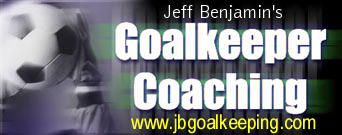
|
"Outstanding keeper instruction. This is a must for goalkeepers and coaches." —Ottawa Internationals S.C. web site, Ottawa, Canada |

|

|
Top |
Goalkeeping Tips, Tidbits and Random Thoughts
An athlete talking to themsleves during competition is hardly a new phenomenon.... The talk does not have to be vocal. By merely thinking you are talking to yourself and sending a message.
-- Tony DiCicco, Goalkeeper Soccer Training Manual
If you have a question, comment or rebuttal you'd like to see addressed here, send me email. I will post your mail to the blog at my discretion unless you specify otherwise.
How do I make my goal kick better?
Many of the emails I get, and questions from players I train, have to do with goal kicks. "My goal kick sucks. How do I make my goal kick better?"There are a few factors that go into getting a 70-yard goal kick. One that should not be discounted is the ball! The one the pros use is light, bouncy and pumped up to full specifications, which means quite hard. Hit it well, and off it goes! You simply won't get the same distance from a cheap, flat ball. It's all in the physics (inelastic vs elastic collisions: a hard ball gets closer to an elastic collision where the energy is transfered to the ball; a dead, flat ball absorbs much of the energy in a more inelastic collision).
The next big factor is the speed (acceleration) of the kicking foot. Taking a long last stride into the ball will lever the upper leg back, making the rotation of the leg about the hip joint. A short stride, and short backswing, means the rotation is mainly from the knee. The longer stride creates a "longer" leg, and thus a greater foot speed (acceleration) for the same rotational speed. Since we know from physics class that F=ma (Force = mass x acceleration), we'll apply more force to the ball due to the greater acceleration.
The contact point of foot on the ball is key as well. The more rigid the ankle and the closer to the center of the ball and the "sweet spot" of the foot we strike, the more elastic the collision will be and the better the energy transfer. We must also strike the underside of the ball, below the midline, for the ball to elevate.
Finally, strength training can help. Leg and core exercises such as lunges, glute-ham raises, reverse hyperextensions, squats, etc. can increase both leg speed and mass, helping both terms on the right of the equation.
It's all part of The Anatomy of the Goal Kick.
Labels: Distribution
Keepers should take goal kicks
The issue of keepers taking goal kicks has come up in email and on discussion boards recently. I originally figured that taking a goal kick is just another type of kick that all soccer players, not just goalkeepers, should practice. But striking driven balls seems to be something missing from many players' skill set and not taught by many coaches.What it boils down to is using proper technique, rather than kicking the stuffing out of the ball. Watch a professional keeper taking a goal kick. They make it look easy to send it 70 yards, don't they? That's because they are relaxed and using proper technique so it is easy. Get the technique down first (see the suggestions on my distribution page) and then add more power.
Another point made in the thread that's important is not to rush the kick. Slow down and get composed first. Then look up, find your target, then look down and focus on the ball all the way through the kick.
Labels: Distribution
Keep the ball secure
Once the goalkeeper has secured the ball in their hands, they should keep it there until they're ready to put it back into play. Don't bounce the ball. It's unneccessary and can only lead to problems. Oh, and if they do roll the ball out to kick it off the ground, make sure that no attackers are lurking about to nick the ball away.Labels: Catching, Distribution